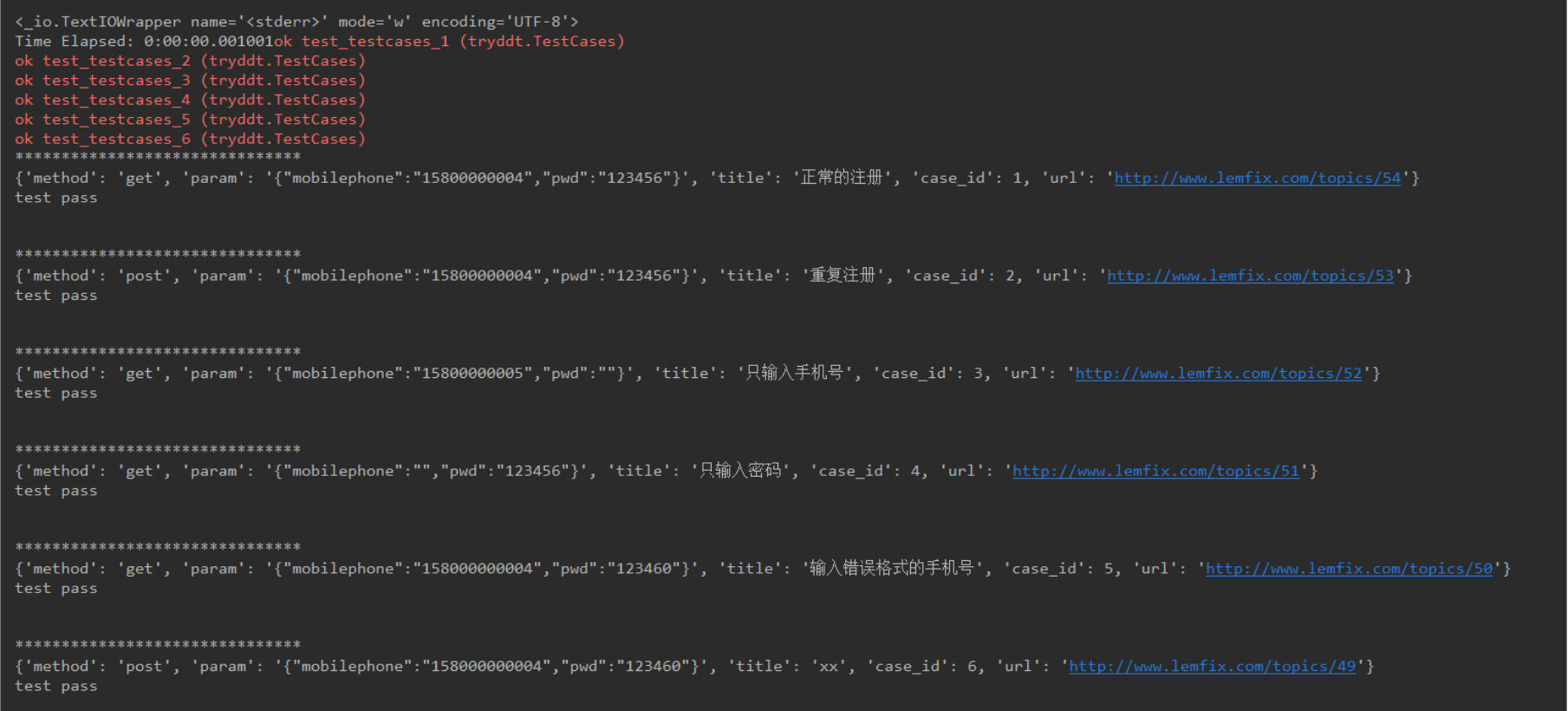介面自動化 之 unittest+ddt+openpyxl 綜合
阿新 • • 發佈:2018-12-13
前面寫過python 之 unittest初探 和 python 之 unittest+ddt 兩篇文章。在之前的文章中,寫過可以再次優化。今天寫第三篇的目的,就是在原有基礎上,基於 openpyxl模組再次優化。在第二篇中,注意到測試資料與程式碼寫在一起,實在是難以維護操作,而我們平時書寫測試用例,記錄測試資料,通常會使用excel檔案或者csv檔案。因此,本篇主要使用openpyxl模組對xlsx檔案的操作,讀取或者寫入資料,做到測試資料與程式碼分離。這樣子測試用例也非常便於維護。 基於書中的原始碼,我做出了一些改動,可以做到在一定格式下,完全讀取excel檔案的測試資料。本次優化,需要先定義一個DoExcel類,在裡面封裝2個方法,一個是讀取測試資料,另一個是寫入資料。 廢話少說,直接上程式碼:
1 #!/usr/bin/python3 2 # -*- coding: utf-8 -*- 3 # @Time :2018/12/11 13:13 4 # @Author :Yosef 5 # @Email :[email protected] 6 # @File: :tryopenpyxl.py 7 # @Software :PyCharm Community Edition 8 import openpyxl 9 class DoExcel(): 10 def __init__(self, filename, sheetname):11 self.filename = filename 12 self.sheetname = sheetname 13 14 ''' 15 讀取檔案中的所有測試資料: 16 ''' 17 def read_data(self): 18 wb = openpyxl.load_workbook(self.filename) 19 sh = wb[self.sheetname] 20 # print(wb.active) 21 22 col_max = sh.max_column23 testdata_key=[] 24 for i in range(1,col_max+1): 25 testdata_key.append(sh.cell(1, i).value) 26 27 testdatas = [] 28 row_max = sh.max_row 29 for i in range(2, row_max+1): 30 testdata = {} 31 for j in range(1, row_max-1): 32 testdata[testdata_key[j-1]] = sh.cell(i, j).value 33 testdatas.append(testdata) 34 35 return testdatas 36 37 ''' 38 往檔案中寫入資料 39 往檔案中寫入資料需要三個引數,分別是row(行),col(列),以及value 40 ''' 41 def write_data(self,row,col,value): 42 wb = openpyxl.load_workbook(self.filename) 43 ws = wb[self.sheetname] 44 45 ws.cell(row,col).value = value 46 wb.save(self.filename) 47 48 if __name__ == "__main__": 49 testdatas = DoExcel("hello.xlsx","data").read_data() 50 # print(testdatas) 51 for item in testdatas: 52 print(item) 53 DoExcel("hello.xlsx","data").write_data(10,10,"Test")
這個類寫好之後,我們就可以在昨天的程式碼裡使用啦~在此之前,我們先看一下excel檔案內容:

然後,在之前的程式碼中稍作修改,將@data後面的具體測試資料換成我們讀取的引數,然後再試一下。
1 import unittest 2 from ddt import ddt, data 3 import HTMLTestRunner 4 import time 5 from auto_test_interface.tryopenpyxl import DoExcel 6 7 testdatas = DoExcel("hello.xlsx","data").read_data() 8 9 @ddt # 代表這個測試類使用了資料驅動ddt 10 class TestCases(unittest.TestCase): 11 12 def setUp(self): 13 print("*******************************") 14 15 def tearDown(self): 16 print("\n") 17 18 @data(*testdatas) 19 def test_testcases(self, value): 20 # print("這是一條測試用例case") 21 print(value) 22 try: 23 24 print("test pass") 25 except Exception as e: 26 print("出錯啦,錯誤結果是%s" % e) 27 print("test failed") 28 raise e 29 30 # if __name__ == "__main__": 31 # unittest.main() 32 33 suite = unittest.TestSuite() 34 loader = unittest.TestLoader() 35 suite.addTest(loader.loadTestsFromTestCase(TestCases)) 36 37 report_dir = "../Test report" 38 now = time.strftime("%Y-%m-%d %H-%M-%S") 39 reportname = report_dir + "/" + now + " Test report.html" 40 41 with open(reportname, "wb+") as file: 42 runner = HTMLTestRunner.HTMLTestRunner(file, 2, title="Model test report", 43 description="Hello testers! This is the description of Model test" 44 "report") 45 runner.run(suite)
執行程式碼之後,我們來看一下控制檯的輸出:

這是HTML的結果:

通過上圖可以看到,在excel中的資料都已被取出。如果需要具體操作某一條資料,只需要從字典裡取值就好了!這裡的程式碼都是為了方便閱讀寫在了一起,自己試的時候,記得按照專案結構來寫呀~如果有不足之處,歡迎各位大佬指正!
